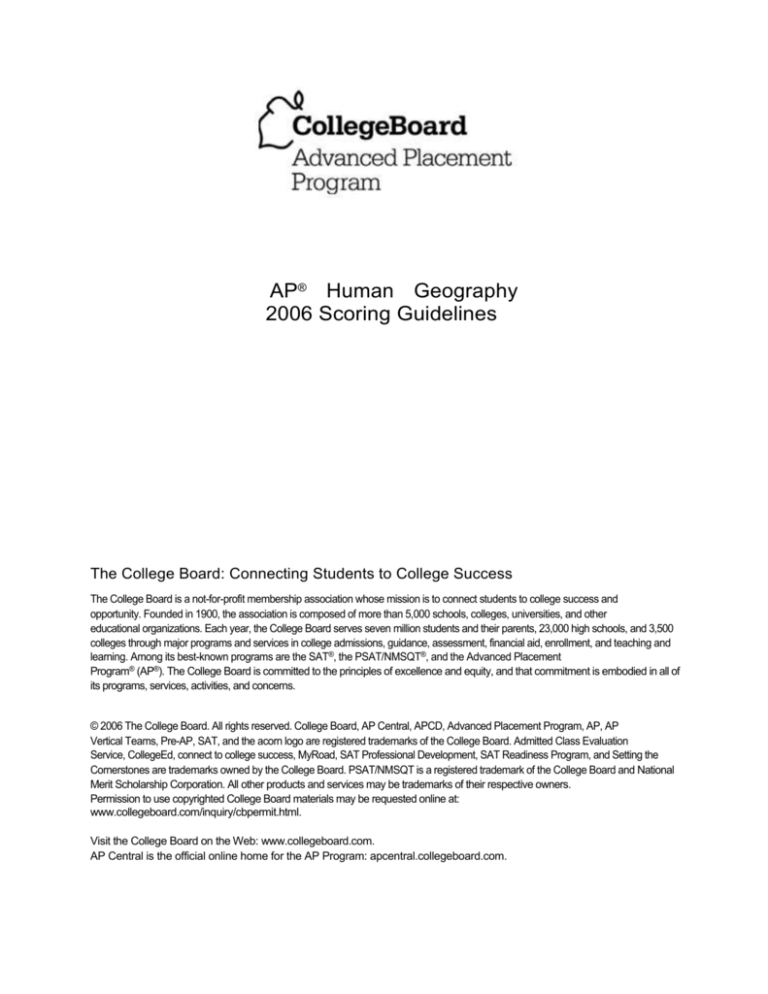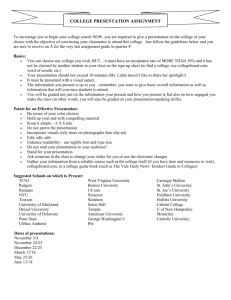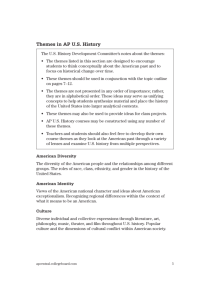
AP® Human Geography
2006 Scoring Guidelines
The College Board: Connecting Students to College Success
The College Board is a not-for-profit membership association whose mission is to connect students to college success and
opportunity. Founded in 1900, the association is composed of more than 5,000 schools, colleges, universities, and other
educational organizations. Each year, the College Board serves seven million students and their parents, 23,000 high schools, and 3,500
colleges through major programs and services in college admissions, guidance, assessment, financial aid, enrollment, and teaching and
learning. Among its best-known programs are the SAT®, the PSAT/NMSQT®, and the Advanced Placement
Program® (AP®). The College Board is committed to the principles of excellence and equity, and that commitment is embodied in all of
its programs, services, activities, and concerns.
© 2006 The College Board. All rights reserved. College Board, AP Central, APCD, Advanced Placement Program, AP, AP
Vertical Teams, Pre-AP, SAT, and the acorn logo are registered trademarks of the College Board. Admitted Class Evaluation
Service, CollegeEd, connect to college success, MyRoad, SAT Professional Development, SAT Readiness Program, and Setting the
Cornerstones are trademarks owned by the College Board. PSAT/NMSQT is a registered trademark of the College Board and National
Merit Scholarship Corporation. All other products and services may be trademarks of their respective owners.
Permission to use copyrighted College Board materials may be requested online at:
www.collegeboard.com/inquiry/cbpermit.html.
Visit the College Board on the Web: www.collegeboard.com.
AP Central is the official online home for the AP Program: apcentral.collegeboard.com.
AP® HUMAN GEOGRAPHY
2006 SCORING GUIDELINES
Question 1
PART A (3 Points)
Define each of the following principles.
Principle
Definition
CorePeriphery
• Uneven spatial distribution of economic, political, or cultural power.
• Must show basic understanding of the relationship between more-developed
and less-developed regions of the world.
Distance
Decay
• Decreased spatial interaction linked to increased distance.
• Decreased influence or intensity of cultural traits and processes with increased
distance.
Chain
Migration
• Once migration starts subsequent migrants will follow earlier migrants.
PART B (6 Points)
For each principle in part A, select a migration stream identified by letter on the map and discuss how the
stream you choose illustrates the principle. Note: Each lettered migration stream may be used only once.
Discussion
1 point: Must specifically identify regions or the groups of people involved in the migration, correctly linked to
the principle defined in part A.
2 points: Discuss specific reason for the migration pattern.
CorePeriphery
• A discussion that shows an understanding of the characteristics of the migration
stream relative to the core-periphery principle.
Distance
Decay
• Greater number of migrants settled at the edge of the country closer to the country
of origin, compared to the number settled on the opposite edge of the country.
• The diminishing evidence of cultural traits by a group on people, if the explanation
clearly shows a link to the fact that due to migration there is less contact between
the migrants and their home country.
• Explanatory factor behind distance decay relationship (e.g., travel cost, information
availability).
Chain
Migration
• Examples must clearly establish a link/transfer of knowledge between the first group
of migrants and subsequent groups OR it should be clear that subsequent migrants
are from areas of close proximity to the source area of the early migrants, and that
they are migrating to the same destination area.
© 2006 The College Board. All rights reserved.
Visit apcentral.collegeboard.com (for AP professionals) and www.collegeboard.com/apstudents (for students and parents).
2
AP® HUMAN GEOGRAPHY
2006 SCORING GUIDELINES
Question 2
PART A (2 points: 1 point for each correct reason)
Identify two reasons why businesses would choose to locate their call centers in small southern towns.
•
•
•
•
•
•
•
Low wage structure
Low tax structure, tax incentives
Low land (site costs) or rent
Low building costs/buildings available
Large labor pool (from deindustrialization) and small town/rural area
Telecommunications in place or easily provided
Business climate, e.g., right to work, zoning
PART B (6 points: For each of 3 examples—1 point for Core Idea; 1 point for Discussion)
Discuss three disadvantages in the use of call centers as a local economic developmental
strategy.
Core Idea(s)
Discussion Points
Low wages
Adds little to local economy through disposable income
Footloose; short term;
unstable employer
Corporate mobility facilitated by globalization of language, communications,
technology, and minimal local investment
Few local resources needs or demands
Future technological advances
Not a long-term contributor to local economic development
Not a provider of goods, so a minimal need for associated services, supplies,
or local linkages
Low multiplier effect
Low spin-off
development
Amount of labor
required is minimal
Skill level requirements
minimal
Part-time employment
Global corporation
Small addition of capital to local economy—highly automated
Jobs requiring basic in-house training
Upward mobility/promotions restricted
Limited improvements on education system
Limited employment benefits
Separation from parent company headquarters does not encourage loyalty to
locality
Low investment requirements
Longevity in the place depends on corporate success, succession of owners
© 2006 The College Board. All rights reserved.
Visit apcentral.collegeboard.com (for AP professionals) and www.collegeboard.com/apstudents (for students and parents).
3
AP® HUMAN GEOGRAPHY
2006 SCORING GUIDELINES
Question 3
PART A (2 points)
Define the concepts “centripetal force” and “centrifugal force.”
1 point:
Generalized definition of centripetal and centrifugal without explicit reference to “viability of a
state” OR one correct definition.
2 points: Centripetal forces unify a state (provide stability, strengthen, bind together, create solidarity)
Centrifugal forces divide a state (lead to balkanization/devolution, disrupt internal order,
destabilize, weaken).
© 2006 The College Board. All rights reserved.
Visit apcentral.collegeboard.com (for AP professionals) and www.collegeboard.com/apstudents (for students and parents).
4
AP® HUMAN GEOGRAPHY
2006 SCORING GUIDELINES
Question 3 (continued)
PART B (2 points: 1 point for generalized identification of a force with a country specified; 2
points for identification of a force with country specified and specific details)
Give a specific example of and explain a centripetal force that affects the viability of any of the states
shown on the map.
Centripetal force
examples
Specific details
Religion
Hinduism in India or Nepal; Islam in Pakistan or Bangladesh; Buddhism
in Bhutan
Language
Urdu (official language), Punjabi or English in Pakistan; Hindi or
English in India; Bengali in Bangladesh
Expressions of national
pride/symbols (generalized:
anthem, sports teams, flag…)
Cricket in India; Place name changes in India
Transportation/
Communication infrastructure
Railroads in India
Raison d’être/Shared history
History of British imperialism; Creation of states (India, Pakistan,
Bangladesh)
India, Pakistan
External threat
Morphology/Compact
state
Sri Lanka, Bhutan
Charismatic or strong leader
Absolute monarchy in Nepal; Military leader in Pakistan
Forward capital
Capital of Pakistan moved from Karachi to Islamabad
Disaster response
Earthquake in Pakistan; Cyclones or flooding in Bangladesh; Tsunami
in India/Sri Lanka—must reference unifying effect on population
Economic-development
programs
Self-sufficiency program in India
Physical geography
Pakistan as a river valley, isolated by mountains and desert
Government
India’s representative democracy
© 2006 The College Board. All rights reserved.
Visit apcentral.collegeboard.com (for AP professionals) and www.collegeboard.com/apstudents (for students and parents).
5
AP® HUMAN GEOGRAPHY
2006 SCORING GUIDELINES
Question 3 (continued)
PART C (2 points: 1 point for generalized identification of a force with a country specified; 2
points for identification of a force with country specified and specific details)
With reference to a different specific example, explain a centrifugal force that affects the viability of any of the
states shown on the map.
Centrifugal force
examples
Specific details
Religion
Islam/Hindu in India or Bangladesh; Buddhist/Hindu in Sri Lanka;
Sunni/Shiite Muslims in Pakistan; Islam/Hindu in Kashmir; Sikhs/
Hindu in India; Jains/Hindu in India
Language
India 14-18 official languages (4 language families); disputes regarding
place name changes in India
Federal
Government/Regionalism
Federal system (28 states) in India
Ethnicities/Separatist
movements
Sikhs in India; Muslims in Kashmir, Tamil/Sinhalese in Sri Lanka,
Maoist rebels in Nepal
Morphology/Fragmented or
Prorupt
Bangladesh exclave in India; Prorupt portion of India
External threat
India, Pakistan
Territorial Disputes
Kashmir dispute between Pakistan and India
Multicore state
Several large cities in India
Physical geography
Mountains divide communities in Nepal
WILL NOT ACCEPT:
• Examples with countries not on the map (e.g., Afghanistan, Burma, Madagascar)
• Same force and country for both B and C (MAY use same country with different forces or same
force with different countries)
© 2006 The College Board. All rights reserved.
Visit apcentral.collegeboard.com (for AP professionals) and www.collegeboard.com/apstudents (for students and parents).
6






